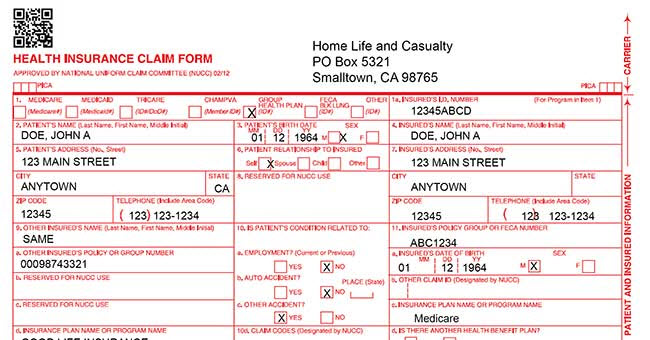
Axis Technical Group and their client, an industry-leading financial services holding company, recently completed a major medical claims processing initiative by leveraging their Axis Machine Learning Solution for Automated Classification, Separation, and Data Extraction running on the Microsoft Azure platform.
Business Problem
The Client processes approximately 9.5 million claims annually, with about 4.5 million coming in the form of paper. The way in which the Client received and handled paper claims with the previous vendor was slow and outdated, primarily due to older technology. The purpose of the project was to address the technology and process changes required for Axis to take over for their previous vendor and ultimately be responsible for converting paper claim forms into textual data.
Complex Document Challenges
The types of documents and files processed included EOB, EOMB, 1500/1450, and UB-04, some of which are incredibly complicated document formats. Due to the complexity of some of these files other attempts to build a solution had failed due to the unavailability of technology obtainable to address such a challenge.
Azure Machine Learning Solution
With 4.5 million paper claims processed annually, the previous technology process, slow and outdated, was due for a significant overhaul. It was experiencing inefficient turnaround times for claims processing as well as an excessive amount of manual claims entry, which was now required due to the previous low OCR capture rate. This Azure Machine Learning solution would require massive processing power and building the application in a cloud environment was the only real option. Microsoft Azure was the go-to choice for its processing capacity and highly extensible machine learning environment.
High-Level Business Requirements
As a Gold Microsoft Partner, Axis was called upon by the Client to take on this massive project and, subsequently, take the proper steps in order to produce a viable solution. Axis’ goals were to implement a Digital Mail Process with the client partner; increase the Auto-Adjudication Rate for Paper Medical Supply Claims, all while complying with EDI HIPAA Standards for the transfer of claims data.
By enhancing the reporting for the claims processing, Axis was able also to expedite the System Exception reporting, improve the communications and controls for the Digital Mail Process, and streamline the Quality Audit Process.
Project Scope
Though the strategic implementation was already in place, individual tasks, team reports, and workflows needed to be executed in order to:
- Implement a process for sending and receiving scanned paper claim forms via email or fax
- Examine existing procedures for the data scrub
- Batch rules and automation jobs that are currently in place for claims processing
- Create a standard file format that will contain the captured claims data with mapped the data types
- Streamline the reject codes and define the rules to identify system exceptions
- Leverage processes to test HIPAA compliance
- Review existing system processes to determine what modifications may be needed
- Identify which files need to be rerouted for manual claims adjudication
- Establish controls and communications for daily transmissions and corrupt records
Benefits
By Axis replacing the previous vendor, overall processes were expedited, and the volume of data entry for paper claims was significantly reduced. In addition to the turnaround time for scanned paper claims being reduced from four days to two, which improved upon delivery times, the OCR capture rates were significantly improved from approximately 33% with the previous vendor to 78% under Axis. In addition, there was an increase in the auto-adjudication rate by having fewer exception errors, which provided peace of mind for the effectiveness of this software.
Business Value and ROI
There are many factors that impact the savings and ROI for the Axis implementation, including the number of people performing manual entry, the number of claims processed, and overall man-hours for adjudication. The Client was able to cut overall claims processing costs by 65% through a combination of automated data extraction and auto-adjudication functionality. This meant 50% cost savings without auto adjudication. Furthermore, 95% of their claims could be adjudicated, which could not have been done so before implementation.
The 78% OCR capture rate that was achieved resulted in a time and cost savings of 10% total savings per medical claim, which equates to $450,000 savings per year.
Keep in mind Axis is capturing info from an EOB, which is the most challenging document to pull data from. It’s important to note that customer EOBs/Remittance Notices delivered to patients from the physician are much different than the EOB supplied to the insurance company.
Medical claims processing is incredibly intricate but is being revolutionized by technology such as Axis Azure Machine Learning solutions to significantly impact overall claims processing accuracy, turn-around times for providers, doctors, and patients, and overall improved reliability between claims data being exchanged between the aforementioned.
By building the solution upon Microsoft Azure, it delivers a robust and flexible cloud platform that provides limitless power and agility to develop, deploy and manage common technical components such as activities, applications, and infrastructures.
Axis professional services and technical know-how of cloud application development helped our clients determine the proper mix of high-performance features that best suit their business needs. This resulted in a choice of Cloud Applications, Composite Solutions, and Hybrid Applications that were cost-effective, scalable, and extensible.
This knowledge acquired from this implementation can now be applied to an array of document processing applications within the client’s environment or even for other client projects with similar challenges.
